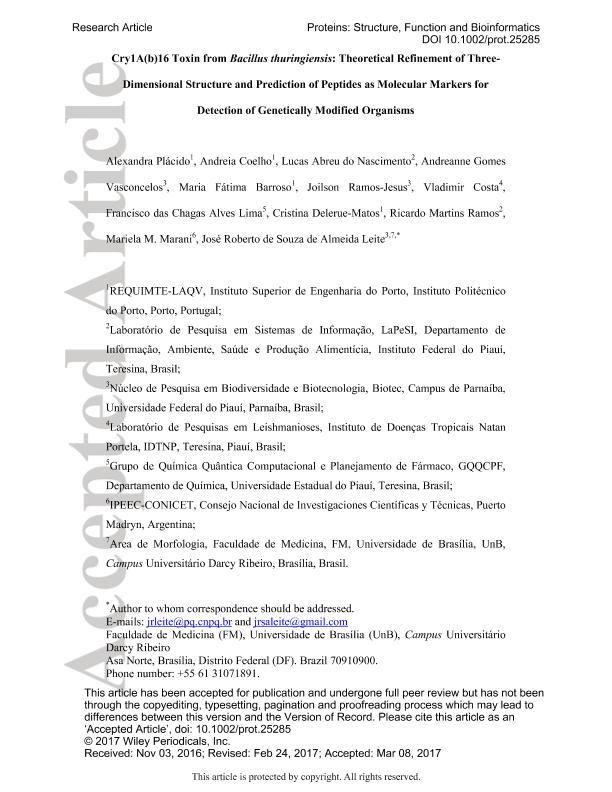Artículo
Cry1A(b)16 toxin from Bacillus thuringiensis: Theoretical refinement of three-dimensional structure and prediction of peptides as molecular markers for detection of genetically modified organisms
Plácido, Alexandra; Coelho, Andreia; Nascimento, Lucas Abreu; Vasconcelos, Andreanne Gomes; Barroso, María Fátima; Ramos Jesús, Joilson; Costa, Vladimir; Lima, Francisco das Chagas Alves; Delerue Matos, Cristina; Ramos, Ricardo Martins; Marani, Mariela Mirta ; Leite, José Roberto de Souza Almeida
; Leite, José Roberto de Souza Almeida
 ; Leite, José Roberto de Souza Almeida
; Leite, José Roberto de Souza Almeida
Fecha de publicación:
07/2017
Editorial:
Wiley-liss, Div John Wiley & Sons Inc
Revista:
Proteins: Structure, Function And Genetics
e-ISSN:
1097-0134
Idioma:
Inglés
Tipo de recurso:
Artículo publicado
Clasificación temática:
Resumen
Transgenic maize produced by the insertion of the Cry transgene into its genome became the second most cultivated crop worldwide. Cry gene from Bacillus thuringiensis kurstaki expresses protein derivatives of crystalline endotoxins which confer insect resistance onto the maize crop. Mandatory labeling of processed food containing or made by genetically modified organisms is in force in many countries, so, it is very urgent to develop fast and practical methods for GMO identification, for example, biosensors. In the absence of an available empirical structure of Cry1A(b)16 protein, a theoretical model was effectively generated, in this work, by homology modeling and molecular dynamics simulations based on two available homologous protein structures. Molecular dynamics simulations were carried out to refine the selected model, and an analysis of its global structure was performed. The refined models of Cry1A(b)16 showed a standard fold and structural characteristics similar to those seen in Bacillus thuringiensis Cry1A(a) insecticidal toxin and Bacillus thuringiensis serovar kurstaki Cry1A(c) toxin. After in silico analysis of Cry1A(b)16, two immunoreactive candidate peptides were selected and specific polyclonal antibodies were produced resulting in antibody–peptide interaction. Biosensing devices are expected to be developed for detection of the Cry1A(b) protein as a marker of transgenic maize in food. Proteins 2017; 85:1248–1257.
Archivos asociados
Licencia
Identificadores
Colecciones
Articulos(IPEEC)
Articulos de INSTITUTO PATAGONICO PARA EL ESTUDIO DE LOS ECOSISTEMAS CONTINENTALES
Articulos de INSTITUTO PATAGONICO PARA EL ESTUDIO DE LOS ECOSISTEMAS CONTINENTALES
Citación
Plácido, Alexandra; Coelho, Andreia; Nascimento, Lucas Abreu; Vasconcelos, Andreanne Gomes; Barroso, María Fátima; et al.; Cry1A(b)16 toxin from Bacillus thuringiensis: Theoretical refinement of three-dimensional structure and prediction of peptides as molecular markers for detection of genetically modified organisms; Wiley-liss, Div John Wiley & Sons Inc; Proteins: Structure, Function And Genetics; 85; 7; 7-2017; 1248-1257
Compartir
Altmétricas



